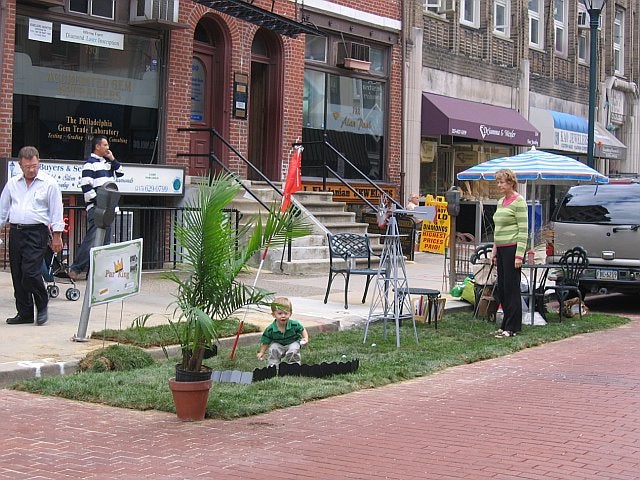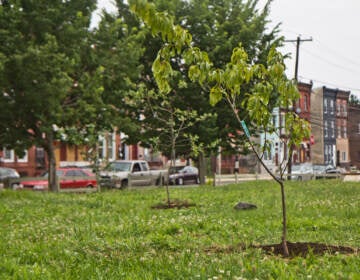Updated: Taking back the streets in style

7th and Sansom
Sept. 19
PARK(ing) Day blog: more photos
By Julie Thompson
For PlanPhilly
Students lounged in lawn chairs at 34th and Walnut Streets, surrounded by sculptures made from recycled aluminum cans. At 12th and Arch, businessmen donned flowered leis and pedaled a stationary bike, powering a slide show set to Hawaiian music. Over at 20th and Appletree, half a city block’s worth of parking spaces were turned into a veritable urban forest, where staff meetings were held and office workers enjoyed lunch outside.
Philadelphia’s first annual PARK(ing) Day was in full swing, drawing crowds all over the city to take part in a large-scale experiment using urban parking spaces for anything other than storing cars. Over thirty teams of architects, nonprofits, students, and interested citizens turned dozens of parking spaces all over the city into islands of green space, art installations, and demonstrations of sustainable urban transportation and design.
First begun in San Francisco in 2005 by REBAR, an art collective, PARK(ing) Day has evolved into an international one-day demonstration of creative uses for parking spaces in cities and towns. Its goal is simple: to convert ordinary metered parking spaces into creatively constructed public spaces, thereby inspiring people to look differently at how streets are used and how we might begin to shift them away from an auto-centric focus to one that incorporates other uses as well.
Throughout the city, this goal was being realized in a variety of visually arresting ways. Interface Studio, a planning and urban design firm, converted a space outside Reading Terminal Market into “The Vacation Lane,” a demonstration of what a ride around Center City would look like if an entire lane of parking was devoted to bicycles. Passersby took turns riding a bike hooked up to a power cord connected to an old slide projector, which showed “dreamscape” images of the city as viewed from a bike.
Along Arch Street, the Community Design Collaborative and the American Institute of Architects constructed the “Park-a-Lounger,” a tiny pocket park made from hay bales and sod, sandwiched between two parked cars. Staff members ate lunch while visitors from the nearby Convention Center did double-takes and stopped to ask questions. One staff member noted that some people who came by had even taken the day off work just to visit PARK(ing) Day sites around the city.
Across from Love Park, a crowd gathered to take a closer look at a parking space literally filled with water—two thousand cups’ worth. Engineered by the Philadelphia City Planning Commission, the space demonstrated how much stormwater runoff is generated by one inch of rainfall on a paved parking space, or about one hundred gallons.
Dave Schaaf, head of the urban design department at PCPC, who spearheaded the concept, explained: “We wanted to create something that would have the most graphic potency in showing how much water is lost to paved areas in the city. Fifty-five percent of Philadelphia’s one hundred and thirty-five square miles are impervious pavement, so we lose a great deal of water every year from these surfaces.”
A unifying theme throughout PARK(ing) Day in Philadelphia seemed to be improvement of the city’s so-called green infrastructure. As two runners passed by the Pennsylvania Horticultural Society’s temporary urban forest at 20th and Appletree, one shouted, “Go green spaces!” The sentiment was met with hearty approval and applause by the twenty or so staffers and passersby enjoying the temporary greenery. Todd Baylson of PHS noted, “PHS wanted to be a creative participant in PARK(ing) Day. It’s a great opportunity to show off the importance of parks.” Of the group’s installation of grass, trees, and benches, Baylson emphasized the partnership effort that took place. The Recreation Department loaned the benches, and the trees were donated by a local nursery and are being planted Saturday at Morris Park in West Philadelphia for a tree-planting day.
Said Tammy Leigh DeMent of PHS, “People have come by and said that it doesn’t feel like they’re on a street when they’re in the space. Even if they don’t always say it, green space just makes people happy.”
In University City, the corner of 34th and Walnut Streets buzzed with activity beyond the normal college bustle. The Bicycle Coalition of Philadelphia launched a demonstration of its Bike Share program, soon to be implemented citywide, renting bicycles for free from two locations, the other at 16th and Locust Streets. Across the street, students from the Penn School of Design demonstrated the potential for alternative and renewable energy use, as well as recycling as art, shown by a human-sized palm tree made entirely from soda cans and mesh wire.
Of the project’s overall mission, Linda Meckel, PennDesign team coordinator, noted, “We devote a lot of urban land to parking in the U.S. At least thirty percent of land in cities is paved for cars, and at least a third or more of that is for parking alone. This day is really aimed at getting people to see what other uses we could provide if we didn’t have those spots. Not that we want to get rid of all parking spaces, but in some cases, wouldn’t we rather have a park? Which is better?”
Contact the reporter at jult@design.upenn.edu
WHYY is your source for fact-based, in-depth journalism and information. As a nonprofit organization, we rely on financial support from readers like you. Please give today.




